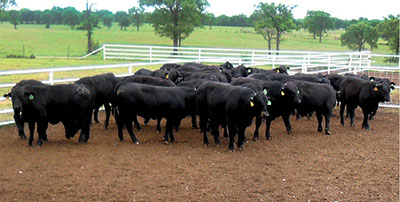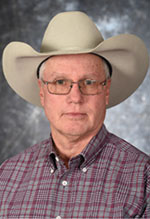Guide B-232
John C. Wenzel
College of Agricultural, Consumer and Environmental Sciences, New Mexico State University
Author: Extension Veterinarian, Department of Extension Animal Sciences and Natural Resources, New Mexico State University. (Print Friendly PDF)
Introduction
In the arid Southwest where pastures are large and stocking densities are small, it is very important that the reproductive ability of beef bulls be evaluated by some measure to ensure that minimum standards of fertility are met. The Society for Theriogenology is an organization of veterinarians dedicated to animal reproduction. Its mission is to promote standards of excellence in reproductive medicine, provide outreach and education to veterinarians, and foster continual improvements in theriogenology. This organization has developed a set of benchmarks, and this “measuring stick” is used by most food animal veterinarians to assist their clientele in their herd health and reproduction decision making.

Photo by John C. Wenzel
Physical Exam
The breeding soundness exam (BSE) is much more than a “semen test.” It consists of a physical exam that should include examination of the eyes, feet and legs, teeth (if an older bull), and general overall condition.
The bull should show a menace (blinking) response when its eyes are examined. Also check for early cancer and other conditions that may have a negative effect on the health or longevity of the bull. Feet and legs should be examined for signs of injury, arthritis, or other conditions that may affect the bull’s mobility. Swelling of joints can be an early sign of problems that may reduce mobility and require the bull to be removed from the breeding herd at an earlier age. Checking the mouth, teeth, and overall condition of older bulls is necessary because bulls in a reduced nutritional state generally have reduced fertility. Body condition score (BCS), especially just prior to turnout, needs to be adequate for the area and nutritional status of the pasture where breeding will occur. In arid areas, a BCS of 5–6 should be targeted at turnout. Young bulls should be monitored closely because loss of body condition can occur very quickly, and they may need supplemental feeding when breeding activity is high.
Reproductive Tract Exam
The anatomy and health of the entire reproductive tract (as much as possible) needs to be evaluated. It is necessary to determine normal status and anatomy, beginning with palpation of the testicles and spermatic cord. If these are normal, measure the scrotal circumference next. The scrotal circumference, along with the age of the bull, is a very important component of the BSE. Table 1 shows the benchmarks set by the Society for Theriogenology for minimum scrotal circumference for all breeds of bulls by age (Table 1).
|
Table 1. Minimum Scrotal Circumference by Age |
|
|
Age (months) |
Size (cm) |
|
<14 |
30 |
|
15–18 |
31 |
|
19–21 |
32 |
|
22–24 |
33 |
|
>24 |
34 |
|
Source: Chenoweth et al., 1992. |
|
Next is rectal palpation of the accessory sex glands and, to some extent, the internal organs to evaluate normalcy. Abnormal findings may need further evaluation or may lead to an immediate diagnosis of an “unsatisfactory potential breeder.” If all organs palpated are found to be normal, next place the rectal probe in preparation for electroejaculation. Stimulation of the bull using an electroejaculator is done next, and needs to result in erection, protrusion of the penis, and ejaculation. It is necessary for every bull to be extended to identify any physical abnormalities associated with the penis and prepuce. Physical abnormalities, such as hair rings, warts, or congenital defects like a persistent frenulum, can be discovered (see Figures 1 and 2 for examples).

Figure 1. Persistent frenulum.

Figure 2. Penile warts.
Semen Exam
Collect a cellular semen sample during ejaculation that can be evaluated under a microscope. This is a two-stage evaluation of motility (movement) and sperm cell morphology (normal or abnormal cell anatomy). Sperm motility needs to be evaluated quickly since motility declines rapidly if environmental temperatures are cool or cold when bulls are being tested. Special precautions need to be taken when testing in cold weather. Sperm cells need to demonstrate a rapidly linear movement pattern, and this can be influenced by the amount of cells present in the ejaculate. Cell motility is the most variable component of the exam because motility can be influenced by many environmental factors. Then a morphological stain is added to the sample, and individual sperm cells are evaluated to determine percent normal sperm cell anatomy. The number and character of the abnormalities present will determine the morphological portion of the final determination. This is also one of the most important components of the BSE because this is used in the prognosis of the bull as a potential breeder.
Other Tests
Other tests or observations may be employed to further evaluate a bull’s suitability to breed cows, such as breeding desire or libido. When purchasing bulls, all available data should be considered. Testing and/or vaccinating for reproductive diseases can be performed at this time. Consult your veterinarian for health recommendations that can be added while the bulls are in the chute for testing.
Results of the Breeding Soundness Exam
After the BSE, three classifications are possible:
Satisfactory potential breeder: All of the parameters evaluated suggest the bull should be able to perform as a breeding bull in a satisfactory manner and is fertile. This classification suggests this bull is acceptable to be turned out with cows for breeding.
Unsatisfactory potential breeder: One or more of the evaluated parameters suggest the bull may not be able to perform as a breeding bull as expected or may be infertile (or have low fertility). This classification suggests this bull is not acceptable to be turned out with cows for breeding.
Deferred: One or more of the parameters evaluated suggest that breeding may be impaired. The cause of the breeding impairment may be a condition that may resolve with treatment or time, suggesting that a re-check BSE will be required at a later date before a final determination can be made. This classification is not uncommon in bulls just reaching puberty.
It is very important to understand that a BSE is an evaluation of parameters on the day the test was performed, with a prediction for the near future. A single BSE is a point in time evaluation, not a lifelong guarantee, because many factors can contribute to a reproductive failure in the bull. Consult with your veterinarian for timing and frequency of performing BSEs on your breeding bulls.
Reference
Chenoweth, P.J., J.C. Spitzer, and F.M. Hopkins. 1992. A new bull breeding soundness evaluation form. In Proceedings, Annual Meeting of the Society of Theriogenology, San Antonio, TX (pp. 63–70).
For Further Reading
B-212: Reproductive Tract Anatomy and Physiology of the Cow
https://https://pubs.nmsu.edu/_b/B212/
B-217: Beef Cow Efficiency in the Southwest
https://pubs.nmsu.edu/_b/B217/
B-222: Cattle Vaccination and Immunity
https://pubs.nmsu.edu/pubs/_b/B222/

John C. Wenzel is the Extension veterinarian in the Extension Animal Sciences and Natural Resources department at NMSU. He earned his B.S. from NMSU and his DVM from Kansas State University College of Veterinary Medicine. His work focuses on cow/calf medicine and preventative health programs for livestock producers in southwestern New Mexico.
To find more resources for your business, home, or family, visit the College of Agricultural, Consumer and Environmental Sciences on the World Wide Web at pubs.nmsu.edu.
Contents of publications may be freely reproduced, with an appropriate citation, for educational purposes. All other rights reserved. For permission to use publications for other purposes, contact pubs@nmsu.edu or the authors listed on the publication.
New Mexico State University is an equal opportunity/affirmative action employer and educator. NMSU and the U.S. Department of Agriculture cooperating.
March 2020 Las Cruces, NM


